origins of Tariq bin Ziyad Amazigh in the light of the Arabic, Islamic and Spanish texts

The practical methodology in historical research relies on returning the primary to the ancient texts always during the research in the sources, as it represents the first source of information and there is often a personal addition from the transmitting writer when transferring the scientific material from the first source, on this basis our research will depend on the first sources closest to The historical event to analyze in order to show the truth about the origins of the Islamic personality Tariq bin Ziyad, who was behind the spread of Islam in the Iberian Peninsula
There is a difference in the sources about the origins of this historical personality, some of which said that he was an Arab from the Umayyad army, and some of them attributed him to Persia, but most opinions see that he is from the North African Amazighs who entered Islam during the era of the Umayyad invasions. It is not difficult to choose the correct one from these different opinions, as it is sufficient to take the consensus of these sources on the use of the phrase “mawla of Musa bin Naseer” when talking about Tariq in order to exclude his Arabic origins, and this is the fact that the phrase “mawla” means in the Arabic-Islamic alphabets non-Arab Muslims Ajam. Whereas the Persians, Amazighs, and Romans who surrendered or were captured in wars were included in the social class called the mawali, which comes in the rank of followers, slaves, or servants after the Muslim Arabs.
It remains for us now to search whether Tariq bin Ziyad was from the Persians or from the Amazighs.
For this purpose, we went back to the oldest references that talked about Tariq bin Ziyad, where the book of the historian Abu Marwan Abd al-Malik bin Habib al-Mirdasi al-Salami (790 AD / 853 AD), an Andalusian theologian of the Maliki school of thought, is considered the oldest source, and he said that Tariq led an army of Amazighs consisting of 12 thousand soldiers For the invasion of Andalusia, he described him as a tall man with blond hair, and he also mentioned that Musa bin Naseer, the Arab Umayyad leader, was present in Kairouan, Tunisia, and he was the one who sent Tariq bin Ziyad to Tlemcen, Algeria, to watch the Andalusians and their boats, and he sent with him a thousand and seven hundred Amazigh soldiers, and on the way to Tlemcen he joined They had other Amazigh soldiers with them until their number decreased to 12,000 Amazighs with only 16 Arabs (The History Book of Ibn Habib al-Mirdasi al-Sulami, page 143)


The leadership of this character to an army of 12,000 Amazighs in the first era of the Amazighs, as well as the characteristics of blondness prevailing among the Amazighs of North Africa since the era of the Pharaohs, as shown to us by the rock drawings in ancient Egypt, and its lack of the Persian element makes us exclude the hypothesis of the Persian origins of this character logical Especially since the oldest sources confirmed to us that he was a Amazigh Amazigh.
Bin Abdul Hakam says:
The killing of Zuhair and his companions was as Yahya bin Bakeer told us on the authority of Al-Layth, in the year seventy-six.
He said: There was a man in the wilderness of Anatolia, called Atiyah bin Yarbu`, from Madhhij.
He went out with his son fleeing from the epidemic, and there was a group of Muslims in that wilderness, so he sought their help and rode among the people around him, so seven hundred men gathered to him, so he crawled with them to the Romans, so they fought them, so they defeated them, and they took refuge in their ships, and the rest of them fled.
This reached Abd al-Aziz bin Marwan, so he sent a boy to her called Talid, and he directed some of the nobles of the people of Egypt with him, so he controlled it.
Yahya bin Bakir told us, on the authority of Al-Layth bin Saad, he said: He commanded Anatolia when Zuhair Tariq was killed, so he made it difficult for the people to lead the leadership of them, because he was a slave, so Abd al-Aziz bin Marwan reached that, so he sent to Talid to free him, and he resided in Istanbul.
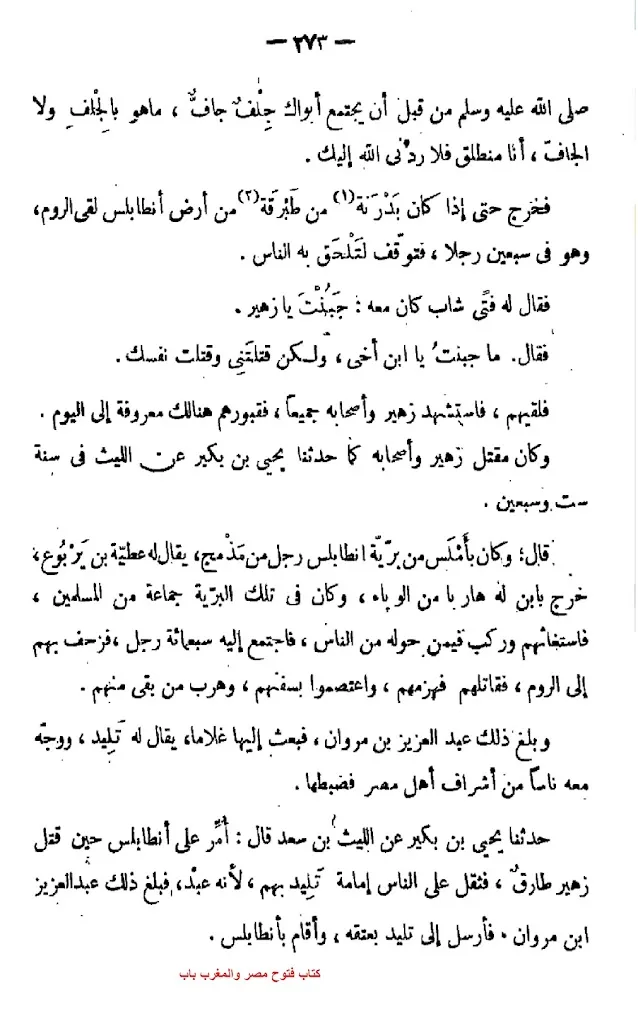
Tariq bin Ziyad the Amazigh in the book of Ibn Abdul Hakam
We find in the book Nuzhat al-Mushtaq fi Intiraq al-Afaq by al-Idris 1100 AD that Tariq Ibn Ziyad is a Amazigh from the Greater Zanata tribe.

We point out here that Ben Wenmua, according to ancient historical references, is a womb from the stomachs of the Algerian Eurasian Warfujumah tribe, one of the branches of the Nafzawa al-Lawata.

The historian Ibn Shabat al-Tawziri 1221 AD in his book Baslat al-Samad, who mentioned that he was from the Eurasian Nafza tribe in Algeria
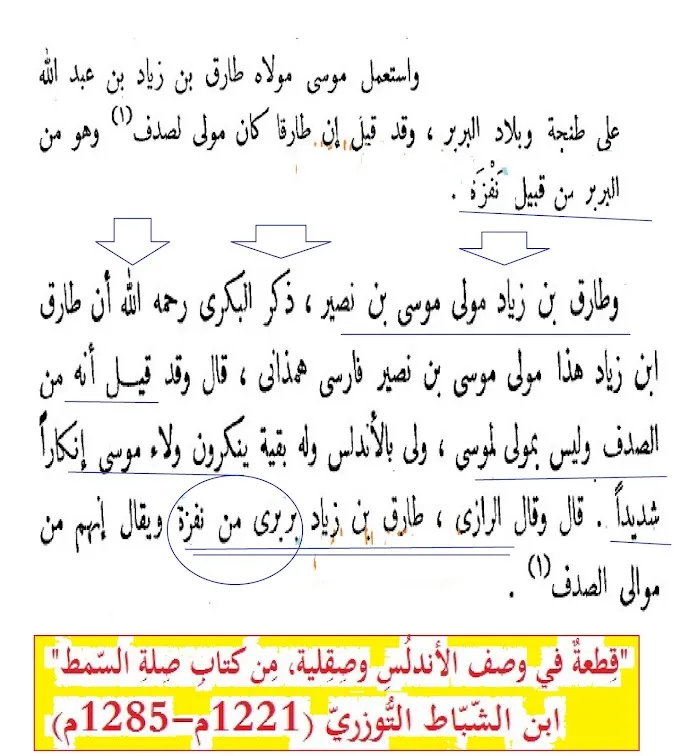
Al-Dhahabi, may God Almighty have mercy on him, said in The History of Islam (6/256):
Most of Musa bin Naseer's army was the Amazighs, and they are a people described as magnanimity and courage, and among them is sincerity and loyalty, and they have high intentions in good and evil, and among them is the king of the country Abu Abdullah Al-Shi'i, Banu Ubaid, Tashfin, his son Yusuf, Ibn Tumart, and Abd al-Mu'min.
From a historical point of view, the beginning of the invasion of Andalusia by the Amazighs, the slave of Kairouan, al-Tabari, Ibn al-Athir and Ibn Adhari confirmed that the first to enter Andalusia was the Berber spy Abu Zara’a Tarif bin Malik al-Barghawati, father of Saleh bin Tarif, the founder of the Barghawati state revolting against the Umayyads, and historians have differed on The religion of the Amazigh Tarif bin Malik, was he a Muslim or a Jew, and after Tarif bin Malik seized the plan of invasion with his Amazigh leader Tariq Ibn Ziyad, descended from the Nafza or Nafzawa tribe, Andalusia was invaded in the year 711 AD (92 AH) under the leadership of Tariq Ibn Ziyad al-Nafzi and 12,000 Amazigh warriors without The knowledge of the Umayyad ruler, Musa Ibn Naseer, and not the Umayyad caliph Al-Walid bin Abd al-Malik, which angered Musa Ibn al-Naseer against Tariq Ibn Ziyad The Umayyad caliph Al-Walid bin Abdul-Malik guarded the two men, so that he isolated them after summoning them and brought them to the Levant, then Musa bin Naseer was imprisoned
And Tariq bin Ziyad disappeared since that incident, and his grave is not known to this day
As for the reason for the invasion of Andalusia, it was the attempt to take revenge on the Prince of Green Island, Julian the Frank, from the King of Iberia, Rutherick the Vandal, who raped Princess Florinda, daughter of Julian, who later incited Tariq Ibn Ziyad to invade Andalusia and subjected him to all his naval ships to transport the Amazigh spy Tarif bin Malik (with 500 men) Then he transferred 12,000 Amazighs warriors to invade Andalusia. (All of these details can be found documented in the book “The History of Africa and Morocco” by Al-Raqiq Al-Kairouani and the book “The History of Nations and Kings” by Abu Ja’far Al-Tabari.)

Historical references confirm that the reason for the disagreement that occurred between Tariq Ibn Ziyad and Musa bin Nusayr after Tariq entered Andalusia is due to the fact that the latter did not inform Musa of the invasion of Andalusia until after conquering it and collecting the spoils. with him. (See the book Al-Rafiq al-Qayrawani from the 10th century A.D. Book, History of Africa and Morocco, Dar Al-Gharb Al-Islami, Beirut, 1990, pg.: 44)
And Musa was informed that Tariq bin Ziyad conquered Andalusia and entered it, so he was afraid that he would have this with the caliph, so he became very angry.
In the same context, Ibn Katheer states that Musa “wrote to Tariq threatening him for entering without his order, and ordering him not to go beyond his place until he caught up with him.”

The lineage of Tariq bin Ziyad to the Amazighs of the Nafza tribe was mentioned by the historian Yahya bin Khaldun, brother of the great historian Abd al-Rahman bin Khaldun, in his book from the 14th century AD in a book.
With the aim of the pioneers in the remembrance of the kings of Bani Abd al-Wad
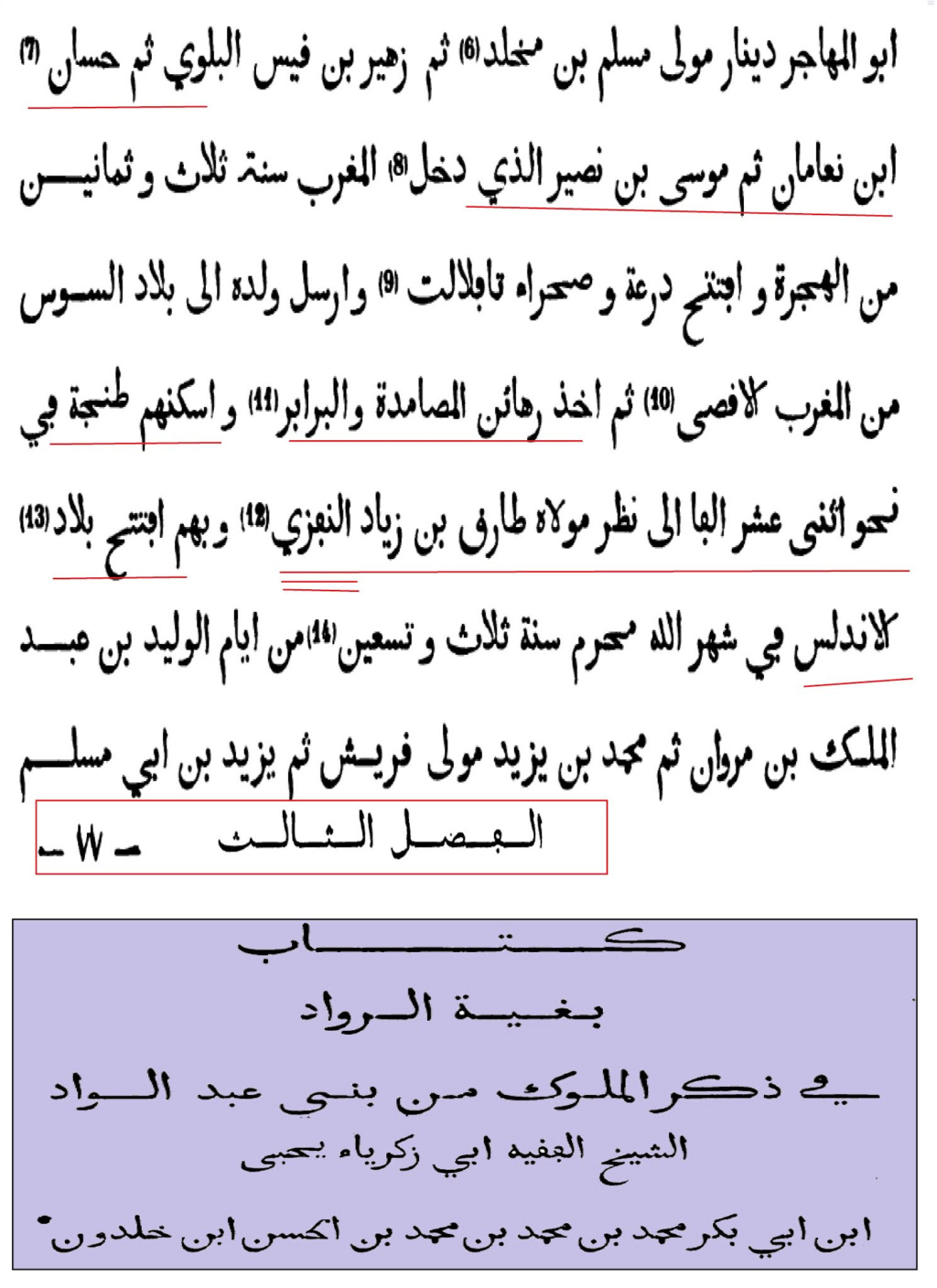
Where did the Amazigh army come from, which was with Tariq Ibn Ziyad?
There is a claim that Tariq bin Ziyad and his Amazigh army are from Tangier, from the Far Maghreb, and their evidence is this talk that Tariq used to live in Tangier, and from there he set out for Gaza Andalusia, but the German leader Adolf Hitler is of Belgian origin, because when he wanted to invade France, he first entered Belgium ?and settled there in preparation to invade France
Most of the old references make sure that Tariq bin Ziyad was a prince over the army that invaded Andalusia, in which the number of the Amazighs was 12 thousand soldiers, as the historian Al-Rafiq Kairouan 1034 AD mentions to us in his book History of Africa and Morocco that the army that was with Tariq bin Ziyad came from the region Auras and that it is the army that was with the Amazigh queen priestess after her death in a battle against the Umayyad leader Hassan bin al-Nu`man al-Ghassani and her children joined the Umayyad Arab army and converted to Islam. They are fighting the remnants of the Romans, and they are also fighting the Amazighs who have not yet surrendered until they settled in the city of Tangier, in the far east of Morocco, at the time of Musa bin Naseer, when Tariq bin Ziyad al-Nafzi commanded them, and then they invaded Andalusia.
Tariq bin Ziyad from the Auras Amazighs
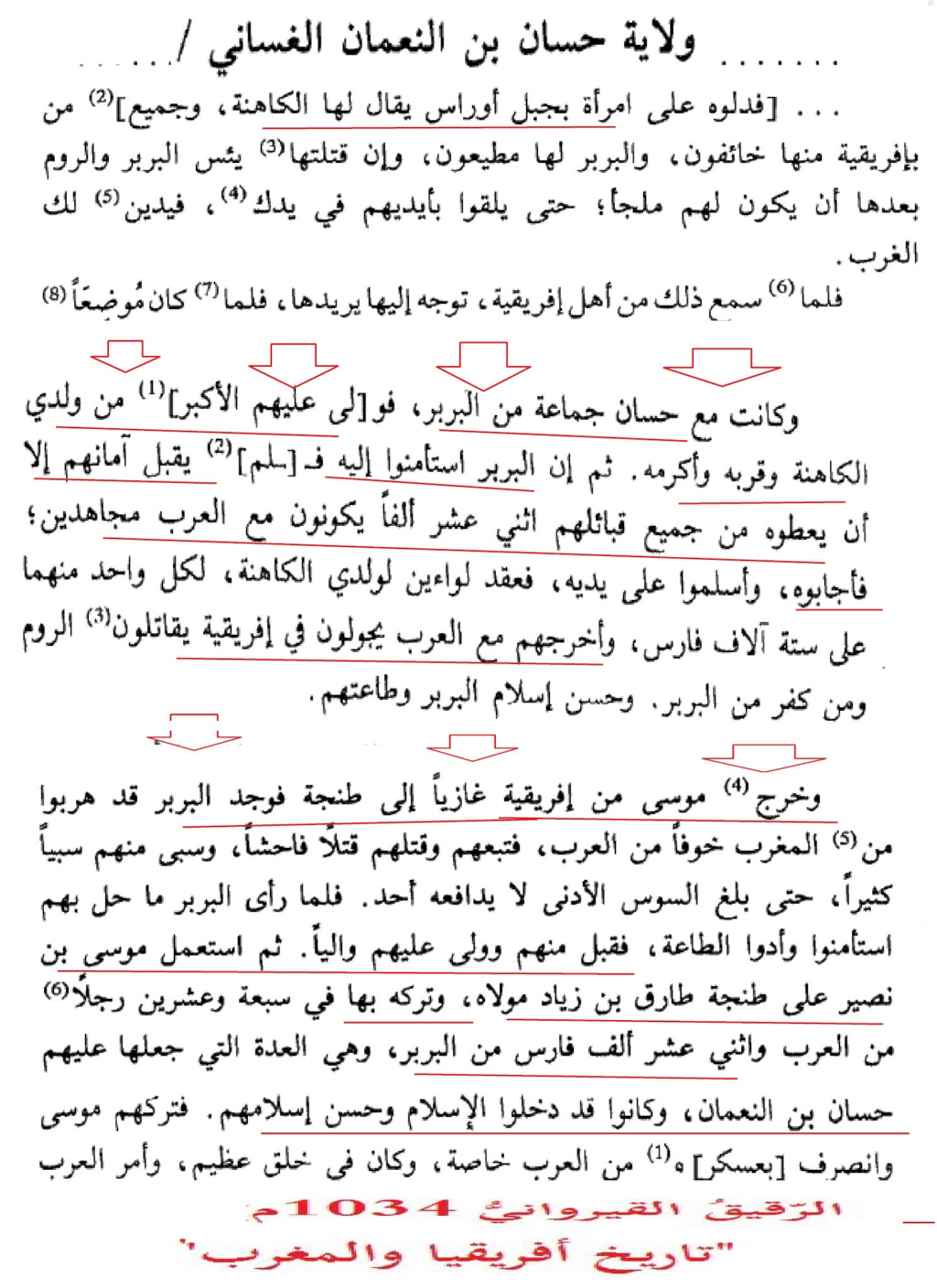
Likewise, the historian Ibn Adhari al-Marrakshi asserts that the army that conquered Andalusia with Tariq bin Ziyad are from the Amazighs of the Algerian Aures region, who were with Queen Dihya (the priestess) at the time of the Arab prince Hassan bin Nouman. Ibn Adhari says that this Amazigh army is from the central Maghreb, meaning from Algeria now .
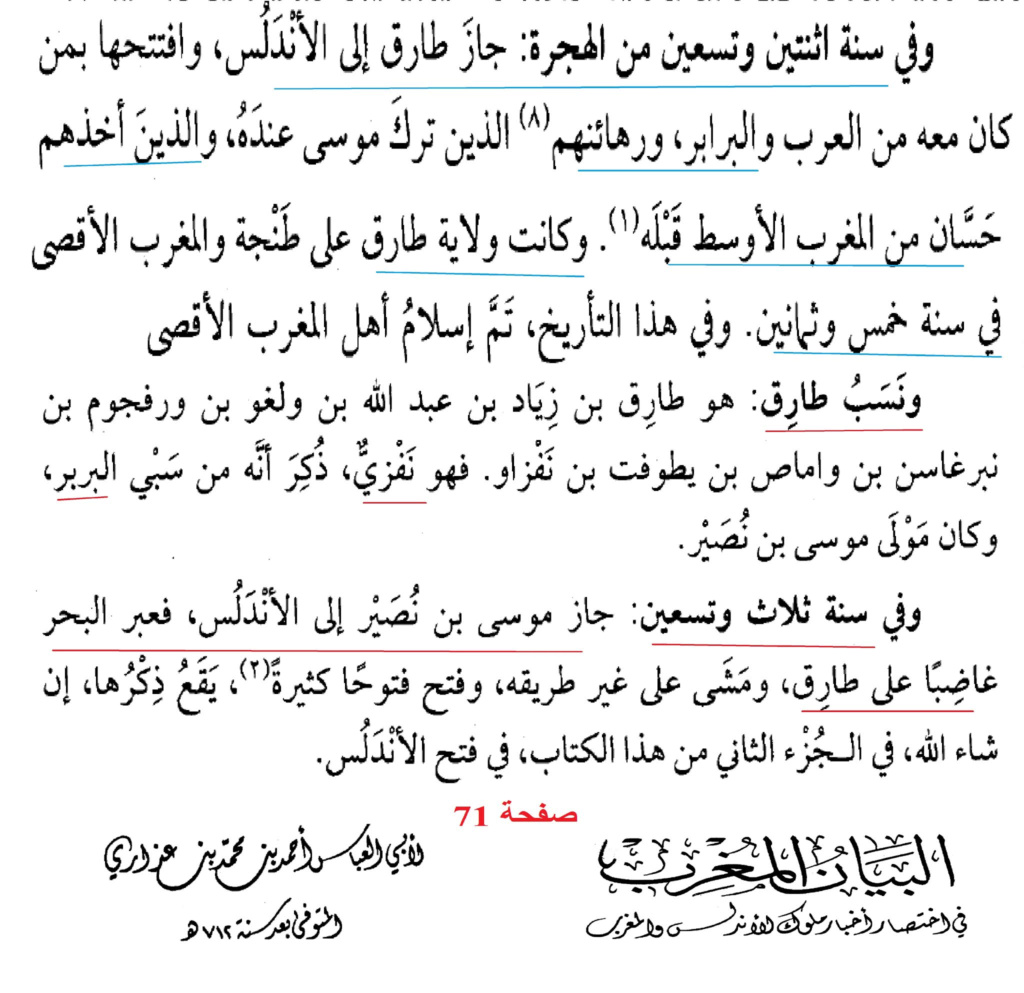
The historian al-Raqiq al-Qayrawani, who is from the 10th century AD, mentioned to us that the time of the appearance of the priestess, i.e. around the year 712 AD, there was a Nafzawa tribe in the areas of the Auras, while we do not find any mention of the Nafza tribe in the Far Maghreb in the ancient historical references at the time of the priestess
See the book on the history of Africa Cyrene.
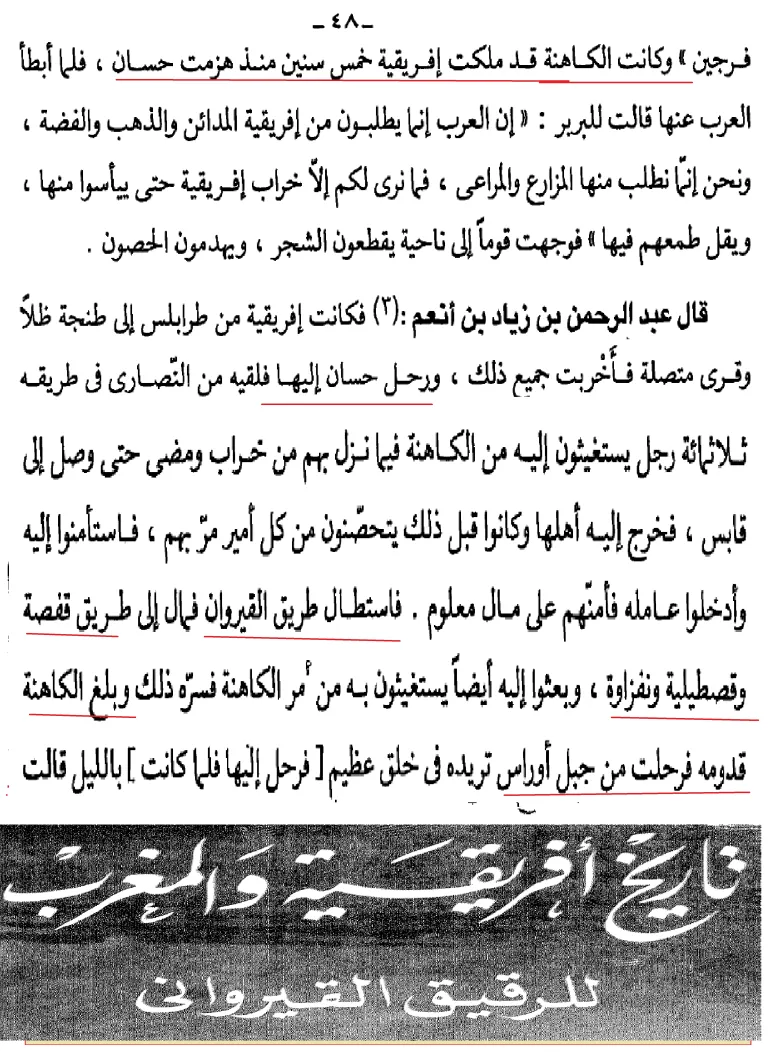
The Amazigh tribe of Nafza, to which Tariq ibn Ziyad is attributed, is presently located in the Aures region, east of Algeria, and exactly it was located in the south of Constantine, most likely in the city of Ain al-Burj, near the city of Siqous, currently affiliated with the state of Umm al-Bawaqi in Algeria. It was mentioned by the traveler and historian Abu Ubaid al-Bakri 1094 AD In the name of Tegis, it is now in the name of Ain Al-Burj, and he specified its location in his book Al-Masalak wa Al-Mamlakat.

It is worth noting that the Nafzawa tribe, to which Tariq bin Ziyad belongs, has spread its branches and branches in several countries, currently in Tripoli, Libya, Tunisia, Algeria and Al-Aqsa Morocco.
It came in the book “Dictionary of Countries” - by the historian Yaqut Al-Hamwi from the 13th century AD - Part 5 - Chapter Noon and Fa
He mentioned two cities in the name of Nafza, the first in the eastern part of Algeria, in the Al-Jerid region, which is on the Tunisian-Algerian border, and mentioned Nafza in the far north of Morocco, in the Andalusia region in the past.
Text adapted from the book Dictionary of countries
Nafzawa: by breaking, then sukoon, zay, and after the alif waw, open: a city of Ifriqiyan works. Al-Bakri said: It travels from Kairouan to Nafzawa for six days towards Morocco. It has six gates, and it has a mosque, a bath, and bus markets, and it has many palm trees and fruits, and around it are many springs, and in its qiblah is an eternal city known as the city, on it is a wall, and it has a mosque and a market, and between the city of Nafzawa and Qabes three days, and between it and Gafsa two stages, and between it and Kitoun three stages, and from Nafzawa it goes to the country Qastiliya and between them is a land in which the road is not guided except by wooden stands and guides. The soldiers and groups of those who entered it perished and did not know their affairs, and this squalid land reaches Ghadames, and it is said: Nafzawa from the outskirts of the Great Zab in Jarid.
Nafza: with conquest then sukoon, and Zay: a city in Morocco in Andalusia, and Al-Salafi said: Nafza, with Kasr Al-Nun, a large tribe, including the Banu Umaira and Banu Malhan residing in Shataba, to which Abu Muhammad Abdullah bin Abi Zaid Abd al-Rahman al-Faqih al-Nafzi is attributed, one of the imams according to the Malik school of thought and has works And Abu al-Abbas Ahmad bin Ali bin Abd al-Rahman al-Nafzi al-Andalusi

Is Tariq bin Ziyad from the Moroccan Nafza or from the Algerian ?Nafza
We notice on social media, such as Facebook and YouTube, a fight between Moroccans and Algerians over the percentage of “Tarik Ibn Ziyad”, each party claiming that his origin is from the country to which he belongs.
And you know that “the personality of Tariq bin Ziyad in Islamic history did not take care of its history, the Arab nationalist historians, nor the Amazigh historians with sufficient clarity in terms of its identity and origins, and there is a difference among some in the tribe to which it belongs, whether it is the Nafza tribe located in Tripoli or Nafzu in the region Nador in Al-Aqsa Morocco or the Nafzawa tribe in the Aures of Algeria
The scientific, historical and logical answer to the place of origin of Tariq bin Ziyad the Amazigh, and by referring to most of the sources and the oldest of them, such as the book Nuzhat al-Mushtaq fi Intiraq al-Afaq by al-Idris 1100 AD. Algerian Eurasian Nafza See the previous documents, also Ibn Adhari al-Marrakshi, we find that he mentions that Tariq ibn Ziyad is from the tribe of Warfjumah from Nafza, and he separated in more proportion than others.
We are rooted in the genealogy of Tariq Ibn Ziyad, which Ibn Adhari mentioned, and it is the oldest detail in the historical references to the origin of Tariq Ibn Ziyad.
Where you find that he belongs to the Warfjouma tribe of Al-Nafzia, and through our knowledge of the origin and branches of the Amazigh tribe of Nafzawa in Ibn Khaldun's book, we find that Warfjouma to which Tariq bin Ziyad belongs is native to the Auras mountains in Algeria, and not the Nafza tribe that is in Al-Aqsa Morocco, especially since the historical references did not Remember any tribe in the name of Warfjumah in the Far Maghreb (see Ibn Khaldun’s Book of Lessons, Part 6, the news about Nafzawa, their stomachs, and their conditions): They are the Banu Taftah bin Nafzaw bin Liwa al-Akbar bin Zahik, and their stomachs are many, such as Ghassasa, Marnisah, Zuhaila, Sumatah, Zatimah, Lhasa, Majrah, and Warsif, and from their stomachs are Mukallata .
It is said that Makalatah was from the Arabs of Yemen who fell to Taftov when he was young and adopted him, and he is not from the Amazighs.
And Mukallata has many stomachs, such as Bani, Riajel, Kiznayah, Bani Yasiltin, Bani Diman, Rahmouq, and Bani Yazanasin.
And from the stomachs and rafjumah of Zakulah, the men of Dhakak bin rafjum, to many other stomachs.
It was and Rvjuma these most handsome stomachs Nafzawa and Ahadhm valor and strength. And when Abd al-Rahman bin Habib deviated from the obedience of Abi Jaafar al-Mansur, and his two brothers Abd al-Warith and Ilias killed him, and his son Habib demanded revenge from them, so Abd al-Warith joined Burfjuma, and he descended on their prince, Asim bin Jamil, in Auras, and he was a priest, so he hired him and invited Abu Jaafar al-Mansur, and a rivalry gathered for him
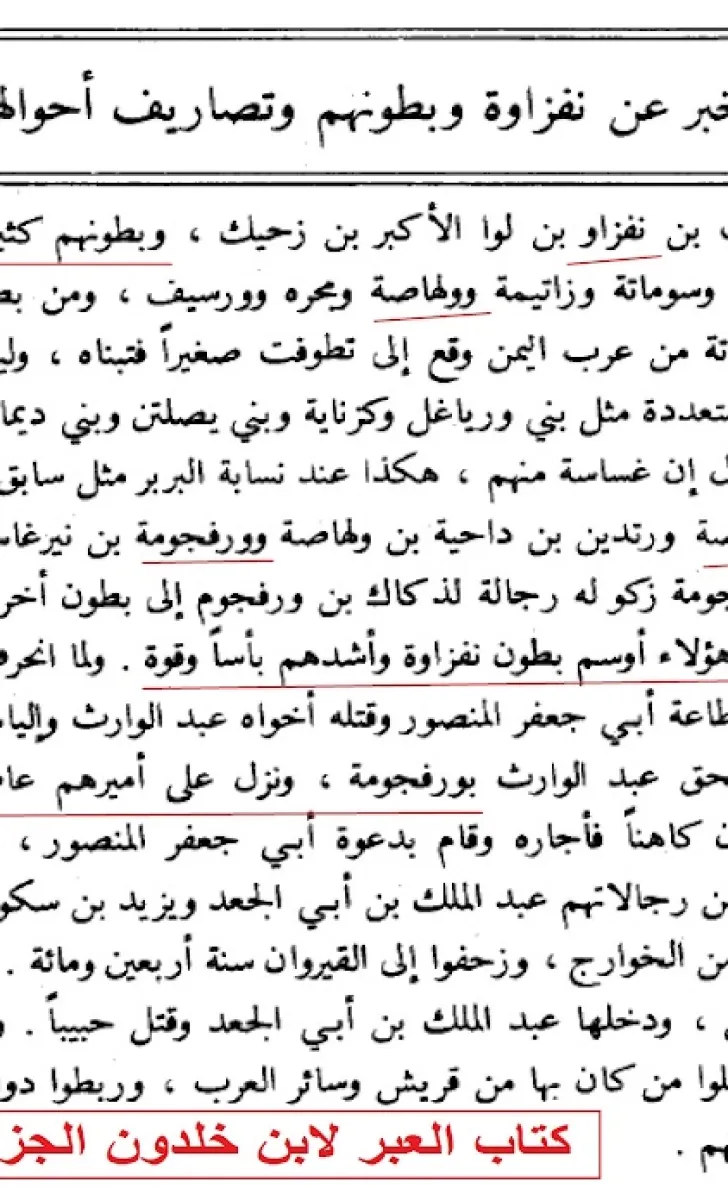
In addition to what was previously mentioned by the historian Al-Maqri Al-Tlemsani from the 17th century AD in the book Nafah Al-Tayyib, page 328, he says that Nafza is from Tripoli. It is from the region of Africa, which at that time includes the geographical area from Tripoli to Tunisia to eastern Algeria now.
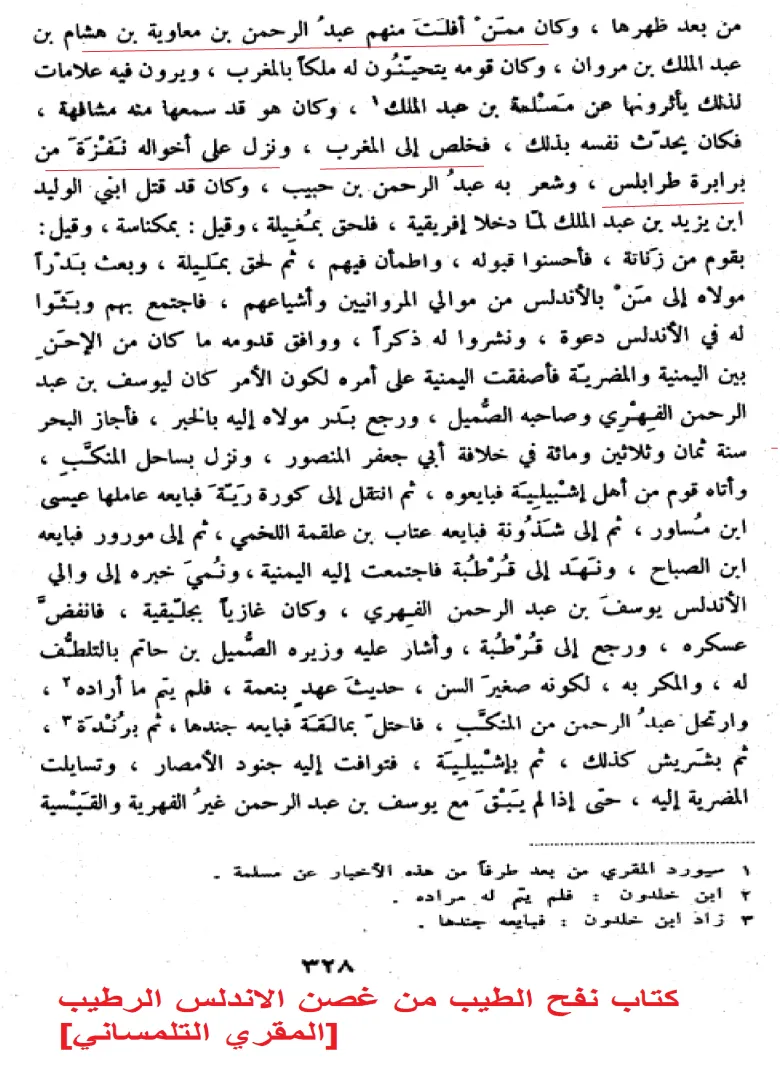
Another evidence from the oldest historical references shows that Tariq bin Ziyad is not from the Far Maghreb, but was in eastern Algeria, then went out to the Far North of Morocco.
It was mentioned in the book Conquests of Egypt and Morocco by the historian Ibn Abd al-Hakam, who died around 871 AD, that Tariq bin Ziyad was not in Tangier, Morocco, but Musa bin Naseer sent him as governor of that region after he dismissed the previous ruler, called Tariq bin Amr, and this is not even Tariq Ibn Ziyad Do not confuse them, as indicated by the historian Ibn Abd al-Hakam, who said that Tariq went out to those regions with his wife, her name was Umm Hakim, and that Tariq settled in Tlemcen, Algeria, and from there he contacted the Spanish prince Julian, who helped him in the occupation of Andalusia. All these data show that Tariq bin Ziyad was his birth and Its origin is the Middle Maghreb region or what is now known as Algeria, not the Far Maghreb
See the book Conquests of Egypt and Morocco
There is other conclusive evidence that shows that Tariq bin Ziyad was originally from Amazighs from the parts of Africa, Tunisia and eastern Algeria, and not from the Far Maghreb, where by researching the ancient references, we find that Tariq bin Ziyad the Amazigh lived, married and left children in the country of Andalusia among the Amazighs tribes and not with the Arabs. It proves that Tariq settled in the Arab East, and documented evidence of this is a book
The genealogy of Ubayd Allah Salih bin Abd al-Halim al-Ilani, who was quoted by the historian Ibn Adhari al-Marrakshi, the lineage of Tariq Ibn Ziyad to the Warfjumah al-Nafziya tribe
Abd al-Halim al-Ilani confirms that Tariq Ibn Ziyad settled in Andalusia with his Amazigh people and left behind children
Adapted from the Genealogy Book of Al-Ilani
When Tariq Ibn Ziyad entered the island of Andalusia and lived there with his Amazigh brothers, they lived there and got married. They said, "We are a Amazigh people, we came with the symbol of jihad, and we are from different races." They said to them, "You have wronged your children who were born here. They grow up and do not know their genealogy." So they sent a group of their prophets until they reached Ifriqiya, so they gathered with those of age among them and wrote that letter for them.
Elani finished speaking
Dear reader, look carefully at the words of the historian Al-Ilani, where he says that Tariq lived with his Amazigh brothers in the country of Andalusia, and this is evidence that Tariq is a Amazigh Amazigh, and if it was otherwise, he would have lived with the arriving Arabs.
Also in the previous text of Al-Ilani, it was mentioned that when the Arabs who followed asked the people with whom Tariq Ibn Ziyad lived, who are you, they told him that they were Berbers (Berbers).
Also, the Amazighs who lived in Andalusia, and Tariq Ibn Ziyad was with them. Al-Ilani mentioned that they got married and lived in Andalusia, and left children. This means that Tariq’s children and grandchildren lived in Andalusia, not in the Arab East.
An important note related to the issue of whether Tariq Ibn Ziyad was originally from Algeria or from the Far Maghreb
We find in al-Ilani’s book an important paragraph detailing this subject. It says in the text that when the descendants and people of Tariq Ibn Ziyad who lived in Andalusia wanted to record their lineage so that it would not be lost, did they go to the Far Maghreb or to the Middle Maghreb and Africa in which the state of Tunisia and eastern Algeria was known in the days of Umayyad occupation
In the previous text of Al-Ilani, it is mentioned that the Amazighs with whom Tariq Ibn Ziyad lived, and to know their Amazigh origins, sent men from their notables to the Africa region, meaning to the regions of Tunisia and eastern Algeria, according to the description and the old meaning of the word Africa. Al-Aqsa and these historical data put a final end to the existing confusion about the origin of Tariq bin Ziyad Al-Warfjoumi Al-Nafzi
See the book Three Arabic Texts on the Amazighs in the Islamic West: The Book of Genealogy by Ibn Abd al-Halim al-Ilani on the following link
https://books.google.fr/books?id=oGY5b2D-RCkC&printsec%D9%82&f=false
And this origin is for Tariq bin Ziyad from the Africa region (Tunisia and eastern Algeria to the end of the Aures), which was referred to by Abd al-Halim al-Ilani, we also find the historian al-Maqri al-Tlemsani from the 17th century CE reaffirming it by saying that Tariq bin Ziyad is from Ifriqiya and he did not say that he is from the Far Maghreb
And al-Maqri al-Tilmisani said that Musa ibn Naseer went out from the Levant to Egypt in a small group to Egypt, and from there he brought soldiers with him. to Tangiers
These data clearly show that Tariq was not present in Tangier or Al-Aqsa Morocco, but rather came to it from Africa and conquered it, and this means that he was not a resident of Al-Aqsa Morocco
?Is Tariq bin Ziyad of Arab origin
As for those who claim that Tariq bin Ziyad is an Arab from the tribe of Laith, their words are historically rejected, and most of the owners of this argument rely on the words of Ibn Khaldun, who mentioned that Tariq bin Ziyadi al-Laithi. Ibn Khaldun and not the words of al-Maqri al-Talmisani, so the source of the lineage of Tariq Ibn Ziyad to Laith is Ibn Khaldun, who did not say to him or Maqri al-Talmisani that Laith is the same as the Adnan Arab tribe, and they did not associate the name of Tariq with the word Arab at all.
From here, the Arab nationalists deliberately and ignorantly claimed that Tariq was from the Arab tribe of Laith, the Kinani Adnanites, and this is false, as we will make it clear to you with references.
Did the historian Ibn Khaldun say that Tariq bin Ziyad is of Arab ?origin
Advocates of Arab nationalism promote that Tariq bin Ziyad is an Arab from the Arab tribe of Laith, and they rely on the words of Ibn Khaldun in the Book of Lessons, part four, the paragraph of Musa bin Naseer, who said the following:
And he took the hostages of Al-Musamdah and brought them down in Tangier, and that was in the year eighty-eight, and Tariq bin Ziyad Al-Laithi was appointed over it. Then Tariq permitted him to Andalusia.
https://shamela.ws/book/12320/2347
Note, dear reader, that Ibn Khaldun referred to the origin of Tariq Ibn Ziyad to a tribe called Laith, and he did not mention its origin, is it an ?Arab tribe, an Amazigh tribe, or something else
But the Arab nationalists who are trying to Arabize the Amazigh characters and Arabize the green and the dry said that Tariq Ibn Ziyad is from the Arab tribe of Laith without investigating the possibility of the existence of a Zanatian Amazigh tribe whose name is also Laith, and it differs from the Arab tribe of Laith, whose lineage goes back to: Laith bin Bakr bin Abd Manat bin Kinana bin Khuzaymah bin Mudraka bin Elias bin Mudar bin Nizar bin Maad bin Adnan.
It is the nature of the Arab nationalist historians that they take advantage of the similarity of the names of the Amazigh tribes with the Arab ones, and that includes attributing the Amazigh personalities and tribes to the Arabs, which is a malicious trick and is well known to academic historians. The goal of today is the countries of the Levant, especially Jordan, and it has nothing to do with the Berber Maghreb or Andalusia, except for some personalities who are affiliated with it.
The shocking thing for the advocates of the Arabism of Tariq bin Ziyad is that when searching for the origin of the Layth tribe in the Maghreb and Andalusia, we find that it is one of the wombs of the Zanata Amazigh tribe that inhabited Andalusia. An Amazigh woman inhabiting Andalusia (see the book Genealogy of the Arabs)
As mentioned to us by the author of the book Bragging of the Amazighs, which dates back to the 13th century AD, that the tribe of Laith is from the stomachs of the Zanata Amazighs.
to alert
The adjective al-Laithi, which is sometimes applied to Amazigh personalities, such as what Ibn Khaldun said on the authority of Tariq Ibn Ziyad al-Laithi, despite the consensus of historians that Tariq is an Amazigh. And many historians attach the adjective al-Laithi to the Amazigh personalities, not because they are from the Canaanite Arab tribe of Laith, but rather because some of the Amazigh personalities converted to Islam at the hands of al-Laithi, and these Amazighs became attributed through their allegiance to al-Laithi and not through lineage.
An example of this is what was mentioned by Judge Ayyad, who is from the 12th century AD
Book: Arrangement of orbits and approximation of paths
Yahya bin Yahya Al-Laithi
Al-Qadi Abu Al-Walid Ibn Al-Fardhi said: Yahya bin Yahya bin Bakeer bin Waslas bin Shamlal bin Saiga. He is called Abu Muhammad. Al-Asili said: Yahya, his father, is the surname of Abu Issa, and he is from Masmouda Tangier and belongs to Bani Laith. He does not know the health reason for this. Al-Razi said in the book Al-Isti’ab: He is from Masmuda, from Mudhara, a tribe of it. Yahya bin Waslas entered, with his nephew Nasr bin Isa, in Tariq's army, and their grandfather Waslas converted to Islam, at the hands of Yazid Ibn Amer al-Laithi, Laith Kinana. This - and God knows best - is the reason for their belonging to Laith. Al-Razi said: Then Katheer bin Waslas, who was Yahya's grandfather, entered after them. And the guardian of his son, Yahya Al-Jazeera, and they shunned him. Yahya asked his son to learn. Abu Omar bin Abdul-Bar, and Katheer said: He is known as Abu Issa. And he entered Andalusia, and they were known as Abu Issa, and knowledge is with God.
Ibn Khaldun indicates that Tariq Ibn Ziyad is a Zanati Amazigh
On the other hand, this is a shocking statement for the Arab nationalists, who propagate that Ibn Khaldun attributes Tariq Ibn Ziyad to the Arabs. For your knowledge, Ibn Khaldun indicates in his book Al-Abr that Tariq Ibn Ziyad is a Amazigh from the Zanata Amazigh tribe, and he clearly mentioned to us that the Al-Maghrawi Emir Al-Zanati Memon Ibn Jabal was the Emir of the Auras in Algeria, in copies Another male named Maymoon bin Jamil is the nephew of Tariq, the conqueror of Andalusia
Quoted from the words of Ibn Khaldun, Book of Lessons, Part VI, Chapter of the first layer of Sanhaja, and what they had of the kingdom
As for the Anjafa, their bellies are parted, and they are the most bellies of the Sanhaja. Sanhaja has a mandate for Ali bin Abi Talib, just as Maghrawa has a mandate for Othman bin Affan, may God Almighty be pleased with them both, but we do not know the reason for this mandate or its origin. Among their famous people in the Islamic state were Thabit bin Wazirion, who rebelled in Ifriqiya during the days of the thug at the time of the extinction of the Umayyads, and Abdullah bin Sudrilak, and Abbad bin Sadiq from the commanders of Hammad bin Belkin and Suleiman bin Mutaman bin Ghaylan during the days of Badis bin Belkin. And Bani Hamdun and Ura Bani Hammad, and he is Hamdoun bin Suleiman bin Muhammad bin Ali bin Alam, among them Maymoon bin Jabal, the nephew of Tariq Mawla Othman bin Affan, the owner of the conquest of Andalusia, among others whose mention is long.
This Khaldounian text shows us that it was an alliance and lineage between the Maghrawa tribe of the Zanatiyyah and its prince, Maymoon bin Jamil in the Algerian Aures, and the Nafza Al-Zanatiyya tribe to which Tariq Ibn Ziyad belongs. Since the time of Caliph Uthman bin Affan, may God be pleased with him, he has been loyal to him and to the Umayyads after him. Amazigh, and as a reminder, Nafzaw, to which Tariq belongs, is the same as the Luwata tribe, as indicated by ancient historians, including Ibn Khaldun.
That is why the Zenata always remained allied with the Umayyads and contributed with them in spreading Islam and the invasions.
And for your information, Al-Ad Maymoon bin Jamil Al-Maghrawi, who was a prince in the Aures at the time of his uncle Tariq Ibn Ziyad, as we explained previously
His children later moved to live in Andalusia, and this is what Ibn Hazm Al-Andalusi mentioned when he mentioned the Amazigh houses in Andalusia.
These are Bani Jamil, the references that we presented to you proved that they were first in command at the time of Tariq Ibn Ziyad, living in the Algerian Aures region, then they moved to Andalusia, and at the present time, after the fall of Andalusia, they migrated to the far north of Morocco, in the direction of Tangiers, and they are still called Bani Jamil, and this indicates that even the tribes In the far north of Morocco, their origin is from the Aures of Algeria
Where it was mentioned in the book of Abd al-Halim al-Ilani, the previous reference, that this Maymoon bin Jamil al-Maghrawi al-Aurasi is the ancestor of the Bani Jamil al-Mastasiya tribe in the far north of Morocco. Therefore, we say that there is no ancient historical reference indicating the presence of the Nafzawa tribe and its clans in the Far Maghreb before the invasion of Tariq bin Ziyad Rather, it is proven that Tariq and Nafza first appeared in eastern Algeria (see the book Three Arabic Texts on the Amazighs in the Islamic Maghreb, page 206).
What is the original home of the Nafzawa tribe, is it the Far Maghreb or Algeria?
Most of the historical references confirm that the Nafzawa, to which Tariq Ibn Ziyad belongs, is a branch of a larger tribe whose name is Nafzaw, and it is the same as Watah Dhikr Ibn Khaldun and Ibn Adhari al-Marrakshi.
Nfzaw = Lua the Younger
Ibn Khaldun mentioned in the Book of Lessons that Lawatah is the same as Nafzaw, and he called it Liwa al-Asghar bin Liwa al-Akbar bin Zuhayk, and that they are nomads from the suburbs of their homeland between Cyrenaica to the very mountains of the Aures in Algeria. Son of the tribe of Nafzawa bin Yatoft bin Liwa the Younger (Lawata)
Excerpted from Ibn Khaldun’s book, Al-Khabar, on the authority of several amputees from the barbarians, and their conditions
It is a large, wide belly from the bellies of the amputee Amazighs. They are related to Liwa al-Asghar bin Liwa al-Akbar Ibn Zuhayk, and Liwa al-Asghar is Nafza. Ibn Hazm mentioned that the Amazigh lineages claim that Sidrata, Luwata, and Mazatah are Copts, and that is not true, and Ibn Hazm did not look at the books of Amazigh scholars on that, and Luwata has many stomachs. Among them are many tribes, such as Sedrata bin Netat bin Liwa, and like Urura bin Ma Salt bin Liwa, Waad Sabeq, and his companions in Banu Salt, other than Uruza, and they are Akrara, Jarmana, and Naqa'ah, such as Banu Zaid bin Liwa. And Hamra and Mudawana, and those who came to them were visible in their homes in the districts of Cyrenaica, as Al-Masoudi mentioned, and they had traces of Abu Yazid’s sedition, and there were among them in the mountain of Auras a great nation. Their cavalry is a thousand, and their men exceed the number, and the state suffices them in collecting from under their hands in Mount Auras
Was Tariq bin Ziyad a slave of Musa bin Nusair or a master of the ?Umayyads
We have already mentioned to you at the beginning of this research that Tariq bin Ziyad was appointed ruler of the city of Cyrenaica immediately after the death of Hassan bin Al-Numan, and this was dozens of years before the emergence of Musa bin Naseer, which indicates that Tariq was not a master, follower, or slave to Musa Ibn Naseer
Some of Tariq's followers in Andalusia strongly denied his allegiance to Musa
See al-Maqri al-Tilmisani’s book, Nafah al-Tayyib (1/ 254), quoting al-Razi.
We also find in the book Portraits of Kings clear evidence of the independence of Tariq bin Ziyad the Amazigh in ruling from the Umayyads. Rather, he was called in the ancient Spanish references the crown prince of the believers. See the book Compendio de crónicas de reyes del Antiguo Testamento
In these references we find pictures and words about Tariq bin Ziyad, who invaded the country of Andalusia, and this is in an old miniature. The picture is dated from the 14th century AD. The document denounces another narration among the many narrations that were falsely attributed to this period, claiming that Tariq Ibn Ziyad was the mawla of any slave of Musa bin A supporter of the Umayyads, while the document before us describes him as the Commander of the Faithful, the King of the Moors and the Supreme Commander of the Mauryan Army
And we all know that the name Moor was given by the Latins to the so-called Muslims in Andalusia in general, Arabs or Amazighs, and to the Amazighs in North Africa, whether in Algeria or the Far Maghreb.
In Adolf Roach's book about the meaning of the word Moore in about the 14th century AD, it meant all the Muslims of North Africa, including Algeria.
Etymologie et definitions diverses du maure's name
Adolphe Bloch
Bulletins et Memoires de la Société d’Anthropologie de Paris Année 1903
https://www.persee.fr/doc/bmsap_0037-8984_1903_num_4_1_7671
Tariq bin Ziyad in the sources

Researcher Adolf Bloch says that the word Moore means all the Muslims of North Africa and Andalusia. It is clear, according to these documents, that Tariq bin Ziyad was a Amazigh king independent of the Umayyad Arabs, and this explains his invasion of Andalusia without the knowledge of the Umayyad caliph in the Levant, nor the Emir of Kairouan in Tunisia, Musa bin Naseer, as mentioned by the Arab references.

The document lists the events of the Moorish Amazigh occupation of Spain, in which King Rodrigo and Count Julian, the ruler of Ceuta, are mentioned in the first paragraph, then he moves on to mention Tariq bin Ziyad and wrote on it
De Africa Tarich el fijo del miramomolin Rey de Marruecos fo muy grandes poderes de moros aribo en Tarifa
And it can be translated as: “From Africa, Tariq bin Amir al-Mu’mineen, king of the Mauryans, who possessed great forces and influence over the Mauryans, arrived in Tarifa.”
The manuscript is also in the National Library of Spain, and can be viewed on the library’s website, Tariq ibn Ziyad and King Rodrigo on page 59.
The source is here
http://bdh-rd.bne.es/viewer.vm?id=0000051546&fbclid=IwAR16uYvd6_K2BdoRN-w4bBWWRy0xki7SEkOKQgcQIJI2l_TDqKezCs_Ldck
In the end, we say that Tariq, whatever his race or gender, he will not increase and nothing will decrease in the Arabs or in the Amazighs, because the history of the entry of Muslims into Andalusia after Tariq’s stage changed and became a black history of Arab crime and Arab conflicts and Arab Amazighs, which resulted in the fall of Andalusia and its return to its people The original ones. It must be that what is called the lands of Arab-Islamic Andalusia is incorrect. They are Christian Spanish lands that were invaded by the Muslims, the Amazighs, then the Arabs, and expelled its original people, and those who joined it were taken captive or killed, then spread the Arabs and the Amazighs instead of teaching Islam to the indigenous population. Its people are Spanish.
Written by researcher Ahmed Harish
And the discharge of Professor Mustafa samet
Source: websites

